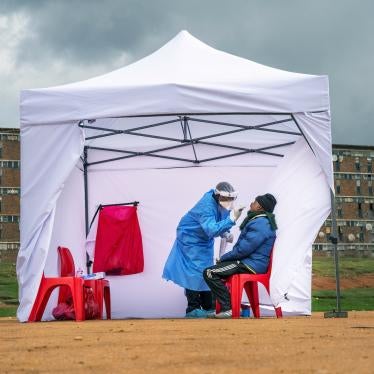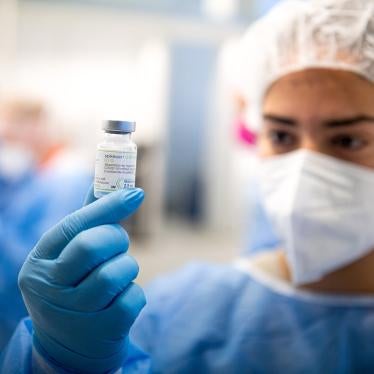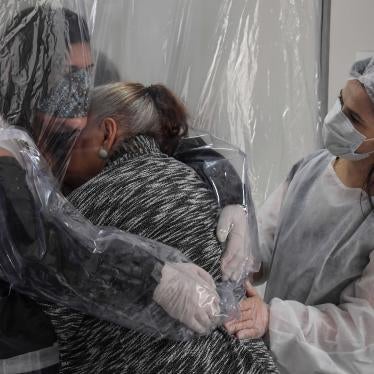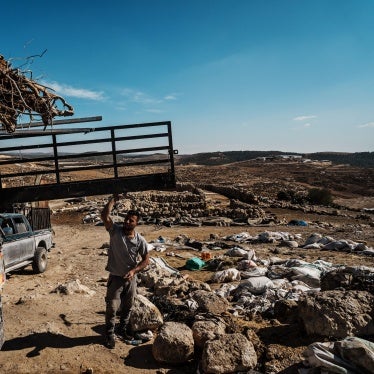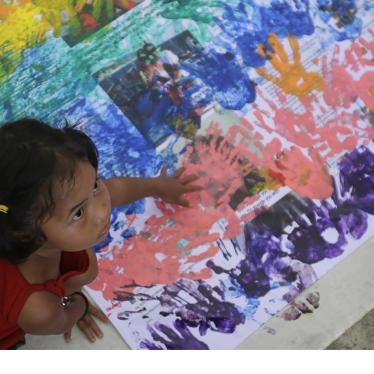Human Rights Watch’s correspondence with Covid-19 vaccine makers can be found here.
A new report by vaccine experts identifying 100+ companies with mRNA manufacturing potential can be found here.
To:
Mary Beth Goodman
Acting Coordinator for Global COVID Response and Health Security
US Department of State
2201 C St., NW
Washington, DC 20520
Cc: Jeff Zients, White House Coronavirus Response Coordinator and Counselor to the President; Ron Klain, White House Chief of Staff; Dr. David Kessler, Chief Science Officer for the COVID-19 Response
Re: Urgent Intervention to Ensure US Covid-19 Vaccine Developers Share Technology
Dear Coordinator Goodman:
We write on behalf of Human Rights Watch and Doctors Without Borders/Médecins Sans Frontières (MSF) USA to urge you to take all available measures to ensure US Covid-19 vaccine developers undertake technology transfers abroad and support the wider manufacture of Covid-19 vaccines to swiftly save lives and protect human rights around the world. The new Covid-19 virus Variant of Concern, Omicron, and emerging surges of the pandemic, make US government action more urgent.
While the US and other high-income governments are administering booster shots and third doses, many people at high-risk of severe illness and death in low- and middle-income countries are still waiting for their first dose. Severely unequal access to Covid-19 vaccines and global supply shortages continue to threaten health, lives, and livelihoods as new variants emerge. The US pharmaceutical and biotechnology companies Moderna, Pfizer, and Johnson & Johnson (J&J) developed or co-developed lifesaving vaccines, but they have not shared knowledge and technology widely with capable manufacturers in Africa, Asia, and Latin America, hindering the global Covid-19 health response and allowing the virus—including new variants—to spread.
The coordinator of the AccessIBSA Project and a vaccine expert from the Médecins Sans Frontières (MSF) Access Campaign have jointly identified over 100 manufacturers from Africa, Asia, and Latin America with the potential to produce mRNA vaccines.[1] We have enclosed a copy of their report with this letter. In late October, the New York Times identified “10 strong candidates to produce mRNA vaccines in six countries on three continents.” [2] In September 2021, Indian civil society organizations wrote to the US government, listing 34 potential manufacturers in 20 different countries who may be equipped to produce the J&J vaccine.[3]
The US government should urgently identify capable manufacturers from these and other lists and ensure that they, along with relevant WHO technology transfer hubs, have timely access to intellectual property, vaccine technology, and materials needed to support manufacturing.
Transfer of the mRNA technology is of particular importance for global health now and for future pandemic preparedness. The WHO-listed Covid-19 mRNA vaccines showed great efficacy in clinical trials, and are understood to be among the easiest to modify to target new variants such as Omicron.[4] As the MSF Access Campaign has explained, because the production of “mRNA vaccines is a relatively simple cell-free process more akin to biochemical synthesis than traditional cell-based production of vaccines,” it is “easier to standardise and therefore to transfer to more facilities in short timeframes.”[5] In other words, many more manufacturers are capable of receiving mRNA technology transfer than technologies that rely on living cells, so mRNA technology holds out the promise of much more transformational impact on the geographical distribution of vaccine manufacturing. Finally, mRNA technology can be adapted rapidly to target other pathogens, meaning that building vaccine manufacturing capacity may offer significant long-term benefits for public health well beyond the Covid-19 pandemic.[6]
The US government has substantially supported the three US vaccine makers. It provided significant funding for the underlying innovations that brought the Moderna, Pfizer-BioNTech, and J&J vaccines to the public so quickly and is uniquely positioned to ensure the benefits of publicly funded scientific research–especially in the cases of Moderna and J&J–are shared more widely. These companies have had ample opportunities to share technology and knowledge and enable the production of vaccines more widely but have failed to do so.[7]
We urge you to take the following steps to scale up and diversify production and shipments of Covid-19 vaccines, especially prioritizing mRNA technology:
- Urgently take all available measures to ensure that US Covid-19 vaccine developers, particularly for mRNA vaccines, undertake more widespread technology transfers and oversee this process to ensure that as many capable manufacturers as possible from Africa, Asia, and Latin America receive timely access to intellectual property, vaccine technology, and materials needed to support manufacturing.
- Periodically and publicly report on the specific steps the US government has taken to expand technology transfers. This should include reporting on how global potential manufacturing capacity is being utilized and whether technology is being provided to relevant WHO technology sharing hubs.
- Support and work actively towards the adoption of a TRIPS waiver at the World Trade Organization for Covid-19 vaccines and other health products. This would help create a conducive environment for additional vaccine developers and manufacturers in low-and-middle-income countries in the long term.
These steps are in line with human rights obligations to engage in international cooperation to ensure the right to health and that all can benefit from advances in scientific research. Experts have mapped out the US government’s legal authority to act, including under the Defense Production Act.[8] The US government has already used its leverage and executive powers to facilitate collaboration among companies to speed up vaccine manufacturing for domestic use.[9] We strongly urge the US government to use all available regulatory and executive powers to expand technology transfers abroad. In the past, the US Biomedical Advanced Research and Development Authority supported other countries in developing vaccine manufacturing capacity to scale up influenza vaccine production starting in 2005.[10]
The overwhelming majority of vaccine doses delivered by the US vaccine makers Moderna, Pfizer, and J&J have gone to high-income countries, according to data gathered by Airfinity and reported by the People’s Vaccine Alliance.[11] The indefinite prolonging of the pandemic is linked to overreliance on vaccine supply from high-income countries, and while donations play an important role in the current context, an approach focused on charity rather than rights-based capacity building across the globe, is neither effective nor sustainable.
Pledges to redistribute vaccine doses purchased by the US, while welcome, are not enough.[12] As of October 12, 2021, high-income governments had collectively pledged to donate 1.8 billion vaccine doses, but just 14 percent had been delivered, according to Airfinity data cited by the People’s Vaccine Alliance.[13]
The US government’s failure to ensure more widespread technology transfers seriously undermines global efforts to meet human rights obligations regarding international cooperation, right to health and sharing the benefits of scientific research. Leaving pharmaceutical companies to decide where and how vaccines should be manufactured, to whom they should be made available, and at what price and other terms, is an abdication of the US government’s human rights and global health commitments and leadership.
We welcome the US government’s announcement on November 16, 2021 that it will invite US manufacturers to send expressions of interest to bolster vaccine manufacturing in the US starting in the second half of 2022, and donate more vaccine doses.[14] The US government should attach conditions to any new investments to require the sharing of intellectual property and controls on pricing to maximize affordability, and ensure that there are no contractual restrictions placed on the US government’s ability to donate doses abroad, especially to low- and middle-income countries. But an approach that relies on dose donations is not sufficient, continues to significantly skew the supply chain, and leaves supplies unpredictable and precarious.
We also urge the US government to work with other governments for the swift adoption of a TRIPS waiver at the World Trade Organization covering vaccines and other health products. Human Rights Watch and MSF USA welcomed the US government’s announcement in May that it would support a waiver of certain intellectual property and trade rules needed for the Covid-19 health response.[15] We are deeply concerned that a handful of high-income countries continue to block the TRIPS waiver, delaying access to lifesaving vaccines, treatments, and testing.
We have provided additional information in Annex I to demonstrate why long-overdue government intervention and oversight is immediately necessary. We stand ready to discuss this further with you and facilitate expert briefings with technical experts.
We hope the US government will also deliver on ensuring more widespread technology transfers as part of a rights-based approach to Covid-19 vaccine access.
Sincerely,
Akshaya Kumar
Crisis Advocacy Director
Human Rights Watch
Dr. Carrie Teicher
Director of Programs
Doctors Without Borders/Médecins Sans Frontières (MSF) USA
Annex I
I. US Government Intervention is a Human Rights Imperative
US government leadership is critical to swiftly avert more preventable Covid-19 deaths and severe morbidity with Covid-19 vaccines. It will also have a range of other positive, cascading human rights impacts.[16] Expanding and diversifying technology transfers to enable global production of vaccines across all regions is critical not only to help ensure the swiftest possible access to Covid-19 vaccines for everyone, everywhere, but to help develop global manufacturing capacity and achieve the Sustainable Development Goals (especially Goals 3 and 9).[17]
The US government recently pledged to purchase and redistribute another 500 million vaccines to COVAX beginning in 2022.[18] But this pledge will not increase the pace of global vaccine manufacturing, bolster overall supply, nor speed up vaccine shipments. As of October 12, 2021, high-income governments had collectively pledged to donate 1.8 billion vaccine doses, but just 14 percent had been delivered, according to Airfinity data cited by the People’s Vaccine Alliance.[19]
Governments have human rights obligations to internationally cooperate and share the benefits of scientific research.[20] They should refrain from actions that interfere, directly or indirectly, with the enjoyment of rights in other countries: no state should act in ways that frustrate the efforts of other states to fulfill their human rights obligations.
Governments’ right to health obligations include taking measures to prevent third parties, such as corporations, from infringing on human rights not only domestically but also extraterritorially in other countries.[21] States should regulate the international operations of pharmaceutical companies domiciled within their territory or jurisdiction to ensure that they “do not violate economic, social and cultural rights abroad.”[22] Governments should maximize the benefits of publicly funded research for public purposes and hold themselves accountable.
II. Technology Transfers
The US government should ensure that US vaccine developers, especially mRNA producers Moderna and Pfizer, and also J&J share their vaccine technology with as many capable manufacturers as possible. As highlighted and for the reasons provided above, transfer of mRNA technology should be the priority. The absence of government oversight and regulation has allowed these corporations to benefit from public funds—whether those granted for vaccine research and development or advance purchase commitments that reduced the risk to industry—while providing them with wide discretion to decide where, how, and to whom they can license. As a result, Covid-19 vaccine manufacturing remains heavily concentrated in the US and Europe.
Limiting technology transfers to the US and Europe significantly skews the global supply chain, leaving other countries completely dependent on imports and making access to life-saving vaccines precarious and unpredictable, especially during pandemics and epidemics.[23]
A. mRNA Vaccines: Moderna and Pfizer-BioNTech Vaccines
1. Public Funding and Pre-Orders for Moderna and Pfizer’s Covid-19 mRNA Vaccines
The mRNA technology that forms the basis for the Moderna and Pfizer-BioNTech vaccines was developed over years of research with public funds pre-dating the pandemic. For both Moderna and Pfizer, foundational innovations that made these mRNA vaccines possible were funded by the US National Institutes of Health (NIH).[24] In the case of Moderna, agreements between NIH and Moderna reveal that some aspects of the underlying technology was “co-developed by Moderna and investigators from NIAID’s [US National Institute of Allergy and Infectious Diseases] Vaccine Research Center.”[25] These underlying layers of publicly funded research provided a platform for these companies to do additional research to develop their respective Covid-19 mRNA vaccine.
During the Covid-19 pandemic, Moderna received an additional $955 million for its Covid-19 vaccine development from the US government.[26]
The US government also signed advance purchase commitments with Moderna and Pfizer for their respective Covid-19 vaccines, de-risking their investments. The US government pre-ordered US$1.5 billion worth of Pfizer-BioNTech vaccines.[27] In response to Human Rights Watch’s questions, Pfizer stated that its “COVID-19 vaccine research, development and manufacturing costs are entirely self-funded,” and that it has “already invested billions of dollars in the development of the vaccine and Pfizer anticipates incurring additional development and manufacturing costs.”[28]
The Graduate Institute of Geneva’s Global Health Centre estimates that Moderna received at least US$7.3 billion in advance purchase commitments from the US and the European Union.[29] Similarly, the Centre estimates that the Pfizer-BioNTech vaccine received a total of at least US$17.74 billion as advance purchase commitments from the US, the European Union, Israel, and Panama.[30]
2. Moderna’s and Pfizer’s Narrow Approach to Technology Transfers
Based on analysis of Moderna’s and Pfizer’s Covid-19 vaccine contracts, the MSF Access Campaign found that conducting technology transfers, manufacturing vaccines, and beginning shipments from a new manufacturing site has taken about three to seven months.[31] Companies should not be left to determine how, when, and where such processes happen without government oversight.
Human Rights Watch wrote to Pfizer and Moderna about their licensing practices.[32] MSF has also conducted similar inquries with Moderna. Below, we provide an overview of these two companies’ practices and an analysis of where they appear restrictive, why they require government oversight, and the kinds of support these companies may need.
In June 2021, Human Rights Watch wrote to Moderna noting that the company’s vaccine production was currently carried out mostly in the US and Europe with one new site manufacturing drug substance in South Korea.[33] In this letter, Human Rights Watch also noted media reports citing manufacturers from India and Bangladesh that had approached the company, stating they had the capacity to manufacture mRNA vaccines and asking the company about what steps it was taking to transfer technology to build vaccine manufacturing capacity of low- and middle-income countries.[34]
In response, Moderna stated that “[c]onducting technology transfers and ramping up new production lines requires significant time from a limited pool of experienced personnel with the requisite expertise.”[35] Moderna outlined its approach to transfer technology to partners that it is “confident can produce…[its] vaccine with the utmost commitment to safety and quality.”[36] The company admitted that all its manufacturing partners were in the US and Europe, but said it was committed to “pursuing additional partnerships around the world to expedite production and delivery” of its vaccine.[37] The company said it was “continuing to seek out such agreements.”[38] However, the company stated:
We are not aware of idle mRNA manufacturing capacity. Nor are we aware of companies who have developed manufacturing, purification, and medical processes that would allow them to rapidly run clinical trials and then produce a meaningful supply of mRNA vaccine.[39]
Human Rights Watch wrote again to Moderna in July 2021. Among other things, Human Rights Watch again asked Moderna about publicly reported requests from manufacturers in India and Bangladesh, requesting that the company disclose a list of all such requests and what the company’s decision was.[40] In response, a representative from Moderna declined to provide additional details, writing: “I regret that the current demands of the ongoing pandemic make it quite impossible to continue responding to the rather voluminous and complex questions you are sending our way.”[41]
Pfizer stated that its vaccine contains 280 different components, manufactured in 86 different sites across 19 different countries.[42] But these are mostly, if not entirely, in the US and Europe. As the company states, its approach has been to activate its “extensive manufacturing network in Europe and the United States…. favoring global contract manufacturers with broad regulatory approvals and significant available capacity over local contract manufacturers in individual markets.”[43]
Thus far, the company has identified only “a few facilities in the world [that] are able to perform the critical steps needed to manufacture mRNA vaccines and the inputs to produce those vaccines at a large scale.”[44] The company claims it has been constrained to adopt such an approach because “[l]ocalizing vaccines requires a significant lengthy process as well as commitment of technical and personnel resources, resources that could have to be pulled away from … production of the vaccine.”[45] Pfizer named Thermo-Fisher, Sanofi, and Novartis among its contract manufacturers.[46]
Pfizer did not make any firm commitments to additional technology transfers for more diversified and scaled up production. It also did not provide details in response to Human Rights Watch’s questions about manufacturers that have privately requested technology transfers from Pfizer and how many were granted. But Pfizer stated that it was “committed to constructive dialogue with all parties” and “will continue to consider all reasonable options and mechanisms as needed to ensure that the vaccine and any potential therapies to help address the pandemic are accessible to those who need it.”[47]
Human Rights Watch is also concerned that efforts to develop an mRNA vaccine production hub in Africa have not made any progress to date.[48] Neither Moderna nor Pfizer have thus far shared their technology with the WHO mRNA technology transfer hub and have made no commitments to do so in response to Human Rights Watch’s questions.
Moderna’s early October 2021 announcement that it will build an mRNA manufacturing plant in Africa in the coming years does not substitute for participation in the hub, which would better address the urgent public health crisis at hand and help prepare for future pandemics. Moderna’s plant is only expected to be completed within two to four years.[49] The US government has the power to ensure both Moderna and Pfizer share lifesaving technology with the world now.
B. J&J’s adenoviral vector vaccine
1. Public Funding and Pre-Orders for J&J’s Covid-19 Vaccine
The US government provided about $1 billion to J&J as part of a “manufacturing demonstration project” when the company’s clinical trials for its Covid-19 vaccine were underway.[50] Vaccines manufactured using these funds could also be used for the clinical trials.[51] This was in addition to other funds provided by the US government, including $456 million for “clinical trials and other vaccine development activities under an existing, long-term partnership with Janssen,” a wholly owned subsidiary of J&J.[52] The Graduate Institute of Geneva’s Global Health Centre estimates that Janssen received at least US$4.9 billion in advance purchase commitments from the African Union, US, and European Union.[53]
2. J&J’s Narrow Approach to Technology Transfers
In its letter to J&J, Human Rights Watch noted that most of the company’s manufacturing was largely concentrated in the US and Europe. Human Rights Watch further pointed to public writing by experts with knowledge about vaccine manufacturing technologies and intellectual property, stating that the company’s approach to licensing was far more restrictive than others like AstraZeneca and Gamaleya, which use the same underlying adenoviral vector technology. Human Rights Watch also noted reports that the company had declined a request from Biolyse Pharma, a Canadian company, for a license to manufacture its vaccine. Human Rights Watch asked J&J questions about the steps it was taking to scale up and diversify production, and to disclose how many requests it had received from manufacturers for licensing and the company’s decisions with respect to those requests. Despite repeated reminders from Human Rights Watch, the company did not respond.
Experts on access to medicines and intellectual property from India and South Africa have publicly criticized the company for its restrictive licensing and using those countries only for manufacturing vaccines for export.[54] Recent reporting on J&J’s export of vaccines manufactured in South Africa to Europe—instead of supplying countries in Africa at a time when the Delta variant was devastating people there—caused a global uproar, and led the European Commission to commit to ensuring vaccines manufactured in South Africa would supply South Africa and other African countries.[55]
We note the US International Development Finance Corporation’s commitment to provide at least 100 million euros to Aspen Pharmacare, which seeks to “to facilitate an increase in vaccine manufacturing know-how and knowledge sharing within Africa” and Aspen Pharmacare’s statement on November 30 confirming a “non-binding term sheet” with J&J for an agreement that would enable it to manufacture and sell an Aspen-branded Covid-19 vaccine throughout Africa. [56] While this could be an important measure for expanding production in Africa, Aspen Pharmacare’s statement suggests it will rely on J&J to supply the drug substance, falling short of the full technology transfer that would enable independent production. The head of the African Vaccine Acquisition Trust urged Aspen and J&J to ensure that the final deal includes production of the drug substance within the next two years.[57]
[1] Achal Prabhala and Alain Alsalhani, “Pharmaceutical manufacturers across Asia, Africa and Latin America with the technical requirements and quality standards to manufacture mRNA vaccines,” AccessIBSA, December 2021. Copy enclosed with the letter. This includes seven potential manufacturers identified by the MSF Access Campaign in their August 2021 publication: MSF Access Campaign, “Share mRNA Technologies, Save Lives,” August 2021, https://msfaccess.org/sharing-mrna-vaccine-technologies-save-lives (accessed October 20, 2021), Annex 2, p. 6.
[2] Stephanie Nolen, “Here’s Why Developing Countries Can Make mRNA Covid Vaccines,” New York Times, October 22, 2021, https://www.nytimes.com/interactive/2021/10/22/science/developing-country-covid-vaccines.html (accessed November 4, 2021).
[3] “Letter from Indian Civil Society Organisations to Johnson & Johnson -and- the Government of the United States,” September 16, 2021, https://accessibsa.org/indian-civil-society-letter-jj/ (accessed October 20, 2021).
[4] Dr. Zoltán Kis and Zain Rizvi, “How to Make Enough Vaccine for the World in One Year,” Public Citizen, May 26, 2021, https://www.citizen.org/article/how-to-make-enough-vaccine-for-the-world-in-one-year/ (accessed December 8, 2021), p. 9; MSF Access Campaign, “Share mRNA Technologies, Save Lives,” p. 2.
[5] MSF Access Campaign, ibid.
[6] See MSF Access Campaign, “Share mRNA Technologies, Save Lives,” p. 2.
[7] See Annex I of this letter for more details.
[8] See for example, Amy Kapczynski and Jishian Ravinthiran, “How to Vaccinate the World, Part 2,” post to “LPE Blog” (blog), The Law and Political Economy (LPE) Project, May 4, 2021, https://lpeproject.org/blog/how-to-vaccinate-the-world-part-2/ (accessed October 20, 2021); Zain Rizvi, Jishian Ravinthiran, and Amy Kapczynski, “Sharing The Knowledge: How President Joe Biden Can Use The Defense Production Act To End The Pandemic Worldwide,” Health Affairs Blog, August 6, 2021, https://www.healthaffairs.org/do/10.1377/hblog20210804.101816/full/ (accessed November 16, 2021); Christopher J. Morten, Zain Rizvi, and Ameet Sarpatwari, “President Biden Already Has The COVID Vaccine Recipe. He Should Share It,” Health Affairs Blog, September 22, 2021, https://www.healthaffairs.org/do/10.1377/hblog20210922.937772/full/ (accessed November 16, 2021).
[9] Remarks by President Biden on the Administration’s COVID-19 Vaccination Efforts, March 2, 2021, https://www.whitehouse.gov/briefing-room/speeches-remarks/2021/03/02/remarks-by-president-biden-on-the-administrations-covid-19-vaccination-efforts/ (accessed October 20, 2021).
[10] Michael L. Perdue and Rick A. Bright, “United States of America Department of Health and Human Services support for advancing influenza vaccine manufacturing in the developing world,” Vaccine vol. 29, supplement 1 (July 1, 2011), accessed September 28, 2021, doi:10.1016/j.vaccine.2011.02.080.
[11] Rohit Malpani and Alex Maitland, “Dose of Reality: How rich countries and pharmaceutical corporations are breaking their vaccine promises,” The People’s Vaccine Alliance, October 21, 2021, https://app.box.com/s/hk2ezb71vf0sla719jx34v0ehs0l22os (accessed October 28, 2021).
[12] See Annex I of this letter for more details.
[13] Rohit Malpani and Alex Maitland, “Dose of Reality: How rich countries and pharmaceutical corporations are breaking their vaccine promises,” The People’s Vaccine Alliance, October 21, 2021, https://app.box.com/s/hk2ezb71vf0sla719jx34v0ehs0l22os (accessed October 28, 2021).
[14] Sheryl Gay Stolberg, “The U.S. aims to lift Covid vaccine manufacturing to create a billion doses a year, New York Times, November 17, 2021, https://www.nytimes.com/2021/11/17/us/covid-vaccines-supply.html (accessed November 18, 2021).
[15] Margaret Wurth, Aruna Kashyap, and Akshaya Kumar, “Biden Pledges Support for Covid-19 Intellectual Property Waiver,” commentary, Human Rights Dispatch, May 5, 2021, https://www.hrw.org/news/2021/05/05/biden-pledges-support-covid-19-intellectual-property-waiver.
[16] Human Rights Watch, Future Choices: Charting an Equitable Exit from the Covid-19 Pandemic, March 4, 2021, https://www.hrw.org/report/2021/03/04/future-choices/charting-equitable-exit-covid-19-pandemic.
[17] UNDP Oslo Governance Centre, “Goal 3: Good Health and Well-being,” Sustainable Development Goals, https://www1.undp.org/content/oslo-governance-centre/en/home/sustainable-development-goals/goal-3-good-health-and-well-being.html#targets (accessed December 2, 2021); UNDP Oslo Governance Centre, “Goal 9: Industry, Innovation and Infrastructure,” Sustainable Development Goals, https://www1.undp.org/content/oslo-governance-centre/en/home/sustainable-development-goals/goal-9-industry-innovation-and-infrastructure.html#targets (accessed September 27, 2021).
[18] World Health Organization, “Global leaders commit further support for global equitable access to COVID-19 vaccines and COVAX,” September 23, 2021, https://www.who.int/news/item/23-09-2021-global-leaders-commit-further-support-for-global-equitable-access-to-covid-19-vaccines-and-covax (accessed September 28, 2021).
[19] Rohit Malpani and Alex Maitland, “Dose of Reality: How rich countries and pharmaceutical corporations are breaking their vaccine promises,” The People’s Vaccine Alliance, October 21, 2021, https://app.box.com/s/hk2ezb71vf0sla719jx34v0ehs0l22os (accessed October 28, 2021).
[20] International Covenant on Economic, Social and Cultural Rights (ICESCR), adopted December 16, 1966, G.A. Res. 2200A (XXI), 21 U.N. GAOR Supp. (No. 16) at 49, U.N. Doc. A/6316 (1966), 993 U.N.T.S. 3, entered into force January 3, 1976, arts. 2(1) and 15(1) (b); Human Rights Watch, “Whoever Finds the Vaccine Must Share It”: Strengthening Human Rights and Transparency Around Covid-19 Vaccines, October 29, 2020, https://www.hrw.org/report/2020/10/29/whoever-finds-vaccine-must-share-it/strengthening-human-rights-and-transparency, pp. 68-72.
[21] Committee on Economic, Social and Cultural Rights, “Statement on Universal Affordable Vaccination Against Coronavirus Disease (COVID-19), International Cooperation and Intellectual Property,” E/C.12/2021/1, Geneva, April 21, 2021, para. 9.
[22] Ibid.
[23] See for example, International Finance Corporation, “IFC, Proparco, DEG and DFC to Support COVID-19 Vaccine and Pharma Manufacturing in Africa,” May 28, 2021, https://pressroom.ifc.org/all/pages/PressDetail.aspx?ID=26379 (accessed September 27, 2021).
[24] Ryan Cross, “The tiny tweak behind COVID-19 vaccines,” Chemical & Engineering News, September 29, 2020, https://cen.acs.org/pharmaceuticals/vaccines/tiny-tweak-behind-COVID-19/98/i38 (accessed September 26, 2021); Zain Rizvi, “Leading COVID-19 Vaccine Candidates Depend on NIH Technology,” (Public Citizen: Washington, D.C., 2020) https://www.citizen.org/article/leading-covid-19-vaccines-depend-on-nih-technology/ (accessed September 26, 2021); Luis Gil Abinader, “Foundational mRNA patents are subject to the Bayh-Dole Act provisions,” Knowledge Ecology International, November 30, 2020, https://www.keionline.org/34733 (accessed September 26, 2021); Trinity Health et al., “Shareholder Proposal Regarding Report on Access to COVID-19 Products,” US Securities and Exchange Commission, https://www.sec.gov/Archives/edgar/data/78003/000121465921003315/p322211px14a6g.htm (accessed September 27, 2021).
[25] NIH-Moderna Confidential Agreements, https://www.documentcloud.org/documents/6935295-NIH-Moderna-Confidential-Agreements.html (accessed September 27, 2021).
[26] Moderna, “Moderna Announces Expansion of BARDA Agreement to Support Larger Phase 3 Program for Vaccine (mRNA-1273) Against COVID-19,” July 26, 2020, https://investors.modernatx.com/news-releases/news-release-details/moderna-announces-expansion-barda-agreement-support-larger-phase (accessed September 27, 2021).
[27] Pfizer, “Pfizer and BioNTech Announce an Agreement with U.S. Government for Up To 600 Million Doses of mRNA-Based Vaccine Candidate Against SARS-COV-2,” July 22, 2020, https://investors.pfizer.com/investor-news/press-release-details/2020/Pfizer-and-BioNTech-Announce-an-Agreement-with-U.S.-Government-for-up-to-600-Million-Doses-of-mRNA-based-Vaccine-Candidate-Against-SARS-CoV-2/default.aspx (accessed September 27, 2021).
[28] Email from Pfizer to Human Rights Watch, April 26, 2021.
[29] The Global Health Centre, Graduate Institute, Geneva, “COVID-19 Vaccine R&D Investments,” Knowledgeportalia, last updated July 8, 2021, https://www.knowledgeportalia.org/covid19-r-d-funding (accessed September 27, 2021), “Figure 3.2, Vaccine R&D Funding Flow: Advanced purchase agreements (in millions USD).”
[30] Ibid.
[31] MSF Access Campaign, “Share mRNA Technologies, Save Lives,” August 2021, https://msfaccess.org/sharing-mrna-vaccine-technologies-save-lives (accessed September 27, 2021), Annex 1, p. 5.
[32] Letter from Human Rights Watch to Pfizer, April 12, 2021; Follow-up letter from Human Rights Watch to Pfizer, May 14, 2021; Letter from Human Rights Watch to Moderna, June 10, 2021; Follow-up letter from Human Rights Watch to Moderna, July 30, 2021.
[33] Letter from Human Rights Watch to Moderna, June 10, 2021.
[34] “COVID-19 vaccines | Moderna has its 'hands full', Pfizer wants signing of indemnity bond for supplying doses to India,” Moneycontrol, April 18, 2021, https://www.moneycontrol.com/news/india/covid-19-vaccines-moderna-has-its-hands-full-pfizer-wants-signing-of-indemnity-bond-for-supplying-doses-to-india-6783441.html (accessed December 2, 2021).
[35] Moderna’s response to Human Rights Watch, June 29, 2021.
[36] Ibid.
[37] Ibid.
[38] Ibid.
[39] Ibid.
[40] Follow-up letter from Human Rights Watch to Moderna, July 30, 2021.
[41] Email from Moderna to Human Rights Watch, July 30, 2021.
[42] Email from Pfizer to Human Rights Watch, May 28, 2021.
[43] Ibid.
[44] Ibid.
[45] Ibid.
[46] Ibid.
[47] Ibid.
[48] Wendell Roelf, “EXCLUSIVE WHO-backed vaccine hub for Africa to copy Moderna COVID-19 shot,” Reuters, September 15, 2021, https://www.reuters.com/world/africa/exclusive-who-backed-vaccine-hub-africa-copy-moderna-covid-19-shot-2021-09-14/ (accessed December 2, 2021).
[49] Jamie Smyth and Hannah Kuchler, “Moderna plans African factory as vaccine makers battle criticism,” Financial Times, October 7, 2021, https://www.ft.com/content/1be50aae-a774-4ece-993e-2502979292f1 (accessed October 7, 2021).
[50] U.S. Department of Defense, “HHS, DOD Collaborate With Johnson & Johnson to Produce Millions of COVID-19 Investigational Vaccine Doses,” August 5, 2020, https://www.defense.gov/News/Releases/Release/Article/2301220/hhs-dod-collaborate-with-johnson-johnson-to-produce-millions-of-covid-19-invest/ (accessed September 27, 2021).
[51] Ibid.
[52] Ibid.
[53] The Global Health Centre, Graduate Institute, Geneva, “COVID-19 Vaccine R&D Investments,” Knowledgeportalia, last updated July 8, 2021, https://www.knowledgeportalia.org/covid19-r-d-funding (accessed September 27, 2021), “Figure 3.2, Vaccine R&D Funding Flow: Advanced purchase agreements (in millions USD).”
[54] “Letter from Indian Civil Society Organisations to Johnson & Johnson -and- the Government of the United States,” September 16, 2021, https://accessibsa.org/indian-civil-society-letter-jj/ (accessed September 26, 2021); “Activists slam J&J for exporting vaccines produced in South Africa to Europe,” AfricaNews, August 18, 2021, https://www.africanews.com/2021/08/18/activists-slam-j-j-for-exporting-vaccines-produced-in-south-africa-to-europe/ (accessed September 26, 2021).
[55] Lauren Kent and Nimi Princewill, “South Africa will no longer send J&J vaccines to Europe, AU envoy says,” CNN, September 3, 2021, https://www.cnn.com/2021/09/03/africa/africa-vaccine-export-suspended-intl/index.html (accessed September 26, 2021).
[56] Shauneen Beukes, “Aspen confirms non-binding term sheet on manufacture and sale of an Aspen- branded COVID-19 vaccine throughout Africa,” November 30, 2021, https://www.aspenpharma.com/2021/11/30/aspen-confirms-non-binding-term-sheet-on-manufacture-and-sale-of-an-aspen-branded-covid-19-vaccine-throughout-africa/ (accessed November 30, 2021).
[57] Promit Mukherjee, “S.Africa’s Aspen signs deal paving way for J&J COVID vaccine licence,” November 30, 2021, https://www.reuters.com/article/aspen-pharmacare-johnsonjohnson-vaccine-idCNL8N2SL3U8 (accessed November 30, 2021).
